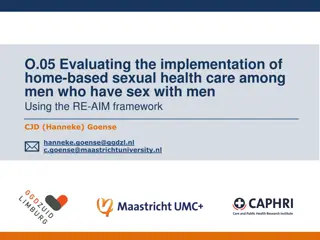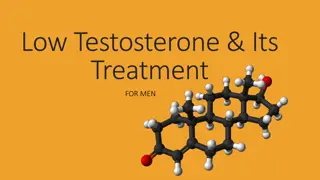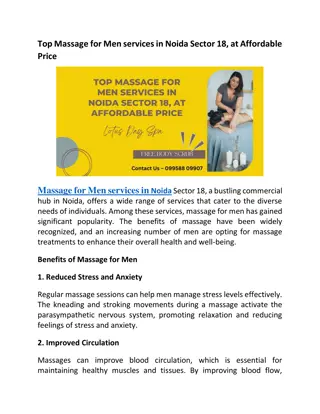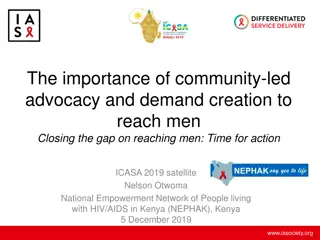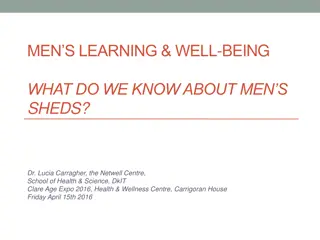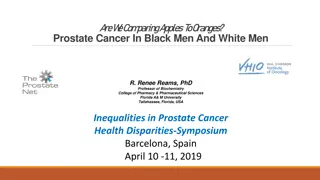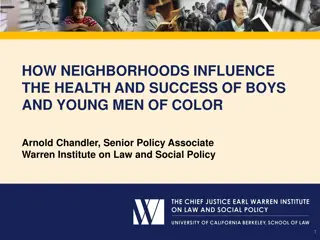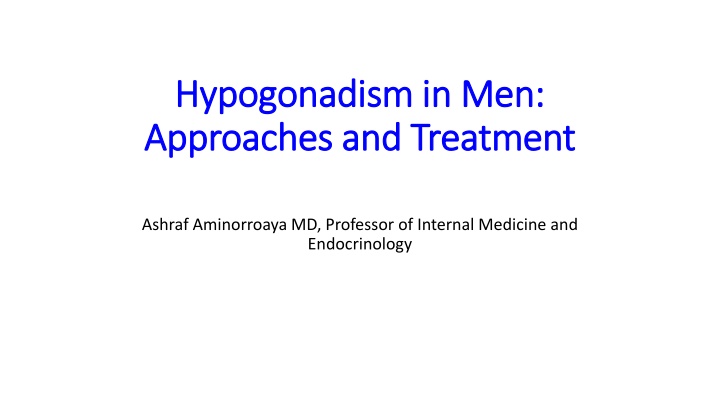
Male Hypogonadism in Men: Approaches and Treatment Insights
Explore the various aspects of male hypogonadism, including primary and secondary causes, symptoms, diagnostic criteria, and treatment options. Gain valuable insights from experts in endocrinology on addressing testosterone deficiency and impairment of sperm production in men.
Download Presentation

Please find below an Image/Link to download the presentation.
The content on the website is provided AS IS for your information and personal use only. It may not be sold, licensed, or shared on other websites without obtaining consent from the author. If you encounter any issues during the download, it is possible that the publisher has removed the file from their server.
You are allowed to download the files provided on this website for personal or commercial use, subject to the condition that they are used lawfully. All files are the property of their respective owners.
The content on the website is provided AS IS for your information and personal use only. It may not be sold, licensed, or shared on other websites without obtaining consent from the author.
E N D
Presentation Transcript
Hypogonadism in Men: Hypogonadism in Men: Approaches and Treatment Approaches and Treatment Ashraf Aminorroaya MD, Professor of Internal Medicine and Endocrinology
Male Hypogonadism Definition Androgen Deficiency and Impairment of Sperm Production Isolated Impairment of Sperm Production or Function with Normal Testosterone Production (include testosterone producing tumors, androgenic anabolic steroids and most men with male infertility, infertility with azoospermia [no sperm], Oligospermia, teratospermia [sperm with abnormal morphologic appearance], asthenospermia [reduced or absent motility], or their combination on spermogram) OR Oligospermia: Mild oligospermia is 10 to 15 million sperm/mL Moderate oligospermia is considered 5 to 10 million sperm/mL. Severe oligospermia is diagnosed when sperm counts fall <5 million sperm/mL. William Textbook of Endocrinology, 14th Edition, 2020
Male Hypogonadism Primary: Primary disorders of the testis (infertility usually not treatable with hormone therapy and requires other options such as donor sperm, ART (e.g. ICSI), or adoption. Medications (androgen synthesis inhibitors) and end-stage renal disease may produce functional primary hypogonadism Intracytoplasmic sperm injection (ICSI) is an in vitro fertilization (IVF) procedure in which a single sperm cell is injected directly into the cytoplasm of an ovum Secondary: Secondary to a disorder of the pituitary or hypothalamus (may be reversible: nutritional deficiency, opioids, glucocorticoid)(fertility may be restored with gonadotropin or GnRH therapy) Combined primary and secondary William Textbook of Endocrinology, 14th Edition, 2020
J Clin Endocrinol Metab, May 2018, 103(5):130 Endocrine Society European Society of Endocrinology European Academy of Andrology
Symptoms Symptoms and Signs Suggestive of and Signs Suggestive of Testosterone Deficiency in Men Deficiency in Men Testosterone Specific symptoms and signs Incomplete or delayed sexual development Loss of body (axillary and pubic) hair Very small testes (<4-6 mL)(<2cm in length) Suggestive symptoms and signs Reduced sexual desire (libido) and activity Decreased spontaneous erections, erectile dysfunction Breast discomfort, gynecomastia Eunuchoidal body proportions Inability to father children, low sperm count Height loss, low-trauma fracture, low BMD Hot flushes, sweats J Clin Endocrinol Metab, May 2018, 103(5):1 30 Endocrine Society European Society of Endocrinology European Academy of Andrology Williams Textbook of Endocrinology, 14th edition, 2020 Nonspecific symptoms and signs associated with testosterone deficiency Decreased energy, motivation, initiative, and self- confidence Feeling sad or blue, depressed mood, persistent low-grade depressive disorder Poor concentration and memory Sleep disturbance, increased sleepiness Mild unexplained anemia (normochromic, normocytic) Reduced muscle bulk and strength Increased body fat, body mass index
Testosterone Measurement Testosterone has significant diurnal and day-to-day variations It may be suppressed by food intake or glucose Total testosterone concentrations should measured on two separate mornings when the patient is fasting Testosterone should be measured if clinically indicated No screening and case detection for hypogonadism J Clin Endocrinol Metab, May 2018, 103(5):1 30 Endocrine Society European Society of Endocrinology European Academy of Andrology
Conditions in Which There Is a Conditions in Which There Is a High prevalence Measure Serum Measure Serum T T Concentrations High prevalence of Low T Concentrations of Low T levels: levels: Pituitary mass, radiation to the pituitary region, or other diseases of the sellar region Treatment with medications that affect T production or metabolism, such as opioids and glucocorticoids Withdrawal from long-term androgenic anabolic steroid (AAS) use HIV-associated weight loss Infertility Osteoporosis or low trauma fracture J Clin Endocrinol Metab, May 2018, 103(5):1 30 Endocrine Society European Society of Endocrinology European Academy of Andrology
J Clin Endocrinol Metab, May 2018, 103(5):130 Endocrine Society European Society of Endocrinology European Academy of Andrology
Total testosterone (TT) and Bioavailable T Serum TT concentration: Sum of unbound and protein-bound T in circulation Most of the circulating T is bound to SHBG and albumin and, to a lesser extent, to cortisol-binding globulin and orosomucoid; only 2.0% to 4.0% of circulating T is unbound or free Bioavailable T: Unbound T plus T bound with low affinity to albumin, reflecting the view that albumin-bound T is dissociable at the capillary level, especially in tissues with relatively long blood transit times (such as the liver and brain), and is biologically available for action in those tissues Bioavailable testosterone concentrations are measured by ammonium sulfate precipitation or calculated from TT, SHBG, and albumin levels J Clin Endocrinol Metab, May 2018, 103(5):1 30 Endocrine Society European Society of Endocrinology European Academy of Andrology
J Clin Endocrinol Metab, May 2018, 103(5):130 Endocrine Society European Society of Endocrinology European Academy of Andrology
Diagnostic approach J Clin Endocrinol Metab, May 2018, 103(5):1 30 Endocrine Society European Society of Endocrinology European Academy of Andrology
Diagnostic Approach LH and FSH assays are susceptible to biotin interference that can cause falsely high or low values; accordingly, clinicians should stop biotin supplements for at least 72 hours before testing J Clin Endocrinol Metab, May 2018, 103(5):1 30 Endocrine Society European Society of Endocrinology European Academy of Andrology
Is pituitary MRI necessary in middle aged and older men with hypogonadotropic hypogonadism? Surveys of middle-aged and older men with secondary hypogonadism and sexual dysfunction have revealed a low prevalence of hypothalamic pituitary abnormalities Clinicians can improve the diagnostic yield of pituitary imaging to exclude pituitary and/or hypothalamic tumors by performing this procedure in men with panhypopituitarism, persistent hyperprolactinemia, serum TT < 1.5ng/mL (5.2 nmol/L), or symptoms of tumor mass effect (e.g., visual impairment, visual field defect, or new onset headache).
Men with Klinefelter Syndrome can benefit from genetic counseling They need surveillance for certain disorders, such as breast cancer and autoimmune disorders, for which they are at increased risk The karyotype obtained from peripheral blood lymphocytes may be normal (46 XY) in some men with KS who have mosaicism (46 XY/47XXY) J Clin Endocrinol Metab, May 2018, 103(5):1 30 Endocrine Society European Society of Endocrinology European Academy of Andrology
Contraindications for testosterone therapy Breast or prostate cancer A palpable prostate nodule or induration Prostate-specific antigen level > 4 ng/mL Prostate-specific antigen 3ng/mL in men at increased risk of prostate cancer without further urological evaluation Elevated hematocrit (more than upper limit of normal range, >48% or >50% in higher altitude) Untreated severe obstructive sleep apnea (>30 apnea/h) Severe lower urinary tract symptoms Desire for fertility in the near term Uncontrolled heart failure Myocardial infarction or stroke within the last 6 months Thrombophilia. J Clin Endocrinol Metab, May 2018, 103(5):1 30 Endocrine Society European Society of Endocrinology European Academy of Andrology
Potential Adverse Effects of Testosterone Replacement Adverse events for which there is evidence of association with T administration Erythrocytosis Acne and oily skin Detection of subclinical prostate cancer Growth of metastatic prostate cancer Reduced sperm production and fertility Uncommon adverse events for which there is weak evidence of association with Testosterone administration Gynecomastia Male pattern balding (familial) Growth of breast cancer Induction or worsening of obstructive sleep apnea Formulation-specific adverse effects: Intramuscular injections of T enanthate, cypionate, or undecanoate Fluctuation in mood or libido Pain at injection site Coughing episodes immediately after the intramuscular injection J Clin Endocrinol Metab, May 2018, 103(5):1 30 Endocrine Society European Society of Endocrinology European Academy of Andrology
Formulation-specific Adverse Effects of Testosterone Replacement Therapy Avoid oral 17 - alkylated T derivatives, such as methyltestosterone and fluxymesterone for T replacement therapy as they are weak androgens with low bioavailability and having potential hepatotoxicity Oral T undecanoate in caster oil, Androil Testocaps absorb via lymphatics, not portal system, T concentrations fall quickly after discontinuation. I is indicated in older men with significant prostate disease and comorbid conditions and in whom low- dose T supplementation is needed J Clin Endocrinol Metab, May 2018, 103(5):1 30 Endocrine Society European Society of Endocrinology European Academy of Andrology William Textbook of Endocrinology, 14th Edition, 2020
Monitoring of Testosterone Replacement Therapy Explain the potential benefits and risks of monitoring for prostate cancer and engage the patient in shared decision making regarding the prostate monitoring plan Evaluate the patient at 3 12 mo after treatment initiation and then annually to assess whether symptoms have responded to treatment and whether the patient is suffering from any adverse effects Monitor T concentrations 3 6 mo after initiation of T therapy: Therapy should aim to raise serum T concentrations into the mid-normal range Injectable T enanthate or cypionate: measure serum T concentrations midway between injections. If mid interval T is > 6ng/mL (24.5 nmol/L) or <3.5 ng/mL (14.1 nmol/L), adjust dose or frequency Check hematocrit at baseline, 3 6 mo after starting treatment, and then annually. If hematocrit is 54%, stop therapy until hematocrit decreases to a safe level; evaluate the patient for hypoxia and sleep apnea; reinitiate therapy with a reduced dose. Testostrone administration does not produce liver toxicity, except 17a-alkylated androgens, so, liver function test monitoring is not recommended J Clin Endocrinol Metab, May 2018, 103(5):1 30 Endocrine Society European Society of Endocrinology European Academy of Andrology William Textbook of Endocrinology, 14th Edition, 2020
Monitoring of Testosterone Replacement Therapy (Cont.) In hypogonadal men receiving T replacement, clinicians should treat osteoporosis in patients at high risk of bone fracture with a pharmacologic agent that has been approved for the treatment of osteoporosis In hypogonadal men who have osteoporosis, are not at high risk of bone fracture, and are being started on T-replacement therapy, clinicians may consider deferring treatment with approved osteoporosis drugs until they have evaluated the response to T replacement by repeating BMD tests of the lumbar spine, femoral neck, and hip after 1 to 2 years of T therapy J Clin Endocrinol Metab, May 2018, 103(5):1 30 Endocrine Society European Society of Endocrinology European Academy of Andrology
Monitoring of Testosterone Replacement Therapy (Cont.) For men 55 69 years of age and for men 40 69 years of age who are at increased risk for prostate cancer who choose prostate monitoring, perform digital rectal examination and check PSA level before initiating treatment; check PSA and perform digital rectal examination 3 12 mo after initiating T treatment, and then in accordance with guidelines for prostate cancer screening depending on the age and race of the patient Obtain urological consultation if there is: An increase in serum PSA concentration 1.4 ng/mL within 12 mo of initiating T treatment A confirmed PSA> 4 ng/mL at any time Detection of a prostatic abnormality on DRE Substantial worsening of LUTS Evaluate formulation-specific adverse effects at each visit J Clin Endocrinol Metab, May 2018, 103(5):1 30 Endocrine Society European Society of Endocrinology European Academy of Andrology
Monitoring treatment with other formulations of Testosterone Replacement Therapy Transdermal gels: assess T concentrations 2 8 h following the gel application, after the patient has been on treatment for at least 1 wk; adjust dose to achieve serumT concentrations in the mid-normal range. Transdermal patches: assess T concentrations 3 12 h after application; adjust dose to achieve T concentration in the mid-normal range. Buccal T bioadhesive tablet: assess concentrations immediately before or after application of fresh system. T pellets: measure T concentrations at the end of the dosing interval. Adjust the number of pellets and/or the dosing interval to maintain serum T concentrations in the midnormal range. Oral T undecanoate: monitor serum T concentrations 3 5h after ingestion with a fat-containing meal. Injectable T undecanoate: measure serum T levels at the end of the dosing interval just prior to the next injection and aim to achieve nadir levels in low-mid range. J Clin Endocrinol Metab, May 2018, 103(5):1 30 Endocrine Society European Society of Endocrinology European Academy of Andrology
Fertility Perform at least two semen analyses separated by an interval of several weeks (at least 1-2 weeks) on semen samples collected within 1 hour of ejaculation after at least 48 hours of abstinence. J Clin Endocrinol Metab, May 2018, 103(5):1 30 Endocrine Society European Society of Endocrinology European Academy of Andrology
Normal Seminal fluid analysis Parameter Sperm concentration Semen Volume Sperm Count Sperm motility Normal Vaalue 15 million/ml 1.5 ml 39 million per ejaculate 40% (progressive and non- progressive) >32%)(progressive sperm motility) 4% normal forms (by strict criteria excluding sperm with mild abnormalities) Sperm morphology William Textbook of Endocrinology, 14th Edition, 2020
Subfertile range of Seminal fluid analysis parameters Parameter Sperm concentration Sperm motility Normal Vaalue <13.5 million/ml <32% (progressive and non- progressive) <9% normal forms (by strict criteria excluding sperm with mild abnormalities) Sperm morphology William Textbook of Endocrinology, 14th Edition, 2020
Fertile range of Seminal fluid analysis parameters Parameter Sperm concentration Semen Volume Sperm Count Sperm motility Sperm morphology Normal Vaalue >48 million/ml 1.5 ml 39 million per ejaculate >63% (progressive and non-progressive) >12% normal forms (by strict criteria excluding sperm with mild abnormalities) William Textbook of Endocrinology, 14th Edition, 2020
Gonadotropin Therapy in secondary hypogonadism To initiate and maintain spermatogenesis to establish and restore fertility hCG: LH like activity (IM or SC injection) hMG: LH+FSH like activity hCG: Initiate with 500-2000 IU SC 2-3 times weekly and increasing to normalize T levels (Eugonadal men range). Up to 3000-5000 IU 2-3 times weekly may be necessary in combined form of hypogonadism (secondary with primary (for e.g. cryptorchidism), if testicular damage is severe, hCG is completely ineffective. In a small proportion of patients with partial gonadotropin deficiency of Prepubertal onset and in almost all men with acquired postpubertal gonadotropin deficiency, treatment with hCG alone may stimulate sperm production. Evidences of partial gonadotropin deficiency: Bilateral testicular volume>8 ml Partial androgenization Low normal serum gonadotropin concentrations Low normal serum Inhibin B concentrations Most men with congenital hypogonadotropic hypogonadism (CHH) require FSH treatment in addition to hCG to stimulate complete spermatogenesis and induce fertility If no sperm is present in the ejaculate after 6-12 months after treatment with hCG and serum T in Eugonadal range, hMG or FSH at a dose of 75 IU three times weekly (increasing up to as much as 300IU SC three times weekly) is added, in combination with the same dose of hCG, for an additional 6-12 months or longer, until spermatogenesis induced. The induction of sperm production by gonadotropin therapy may take 12 to 24 months. William Textbook of Endocrinology, 14th Edition, 2020
Conclusion Male hypogonadism may be hypergonadotropic or hypogonadotropic, functional or organic Treatment of functional hypogonadism depends on the treatment of the etiology, If hypogonadism still persists, testosterone replacement therapy has to be done Contraindications for testosterone therapy: Breast or prostate cancer, a palpable prostate nodule or induration, prostate-specific antigen level 4 ng/mL, prostate-specific antigen 3ng/mL in men at increased risk of prostate cancer without further urological evaluation, elevated hematocrit (more than upper limit of normal range,untreated severe obstructive sleep apnea (>30 apnea /h), severe lower urinary tract symptoms, desire for fertility in the near term, uncontrolled heart failure, myocardial infarction or stroke within the last 6 months, or thrombophilia. Aim of testosterone therapy: To keep testosterone concentrations in the mid-normal range during treatment with any of the approved formulations, by considering patient preference, formulation-specific adverse effects, treatment burden, and cost Monitoring of the patient by evaluating symptoms, testosterone adverse effects, and patient s compliance; measuring serum testosterone and hematocrit concentrations; and evaluating prostate cancer risk during testosterone therapy Gonadotropin therapy for treating infertility in secondary hypogonadism or combination of primary hypogonadism

